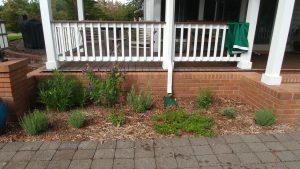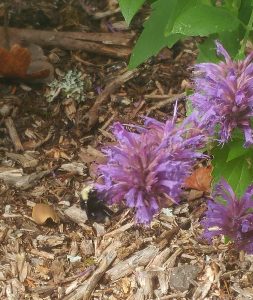You’ll recall that in July I posted about root-washing perennials before planting them in the middle of our typically hot and dry summer in the Pacific Northwest. I wanted to update everyone on how they performed now that we’re heading into our cooler and wetter fall months.
Just to remind you, here’s a photo of the garden right after planting:

And here is the same garden, 3 months later:

No plants died; in fact, as you can tell, they all thrived. They were watered twice a day during the hottest months and now are rain watered only. (The underlying soil is an excessively drained glacial till, which is why we water frequently during esablishment and why we don’t worry about the drainspout. Water doesn’t stay around long.)
I used no fertilizer. I did add the soilless media from the root washing to the top of the soil and then covered with woodchip mulch.
There was, of course, a period of about 6 weeks post planting where there was no above-ground growth. But all of these plants retained their flowers, which kept our bees and other pollinators (butterflies and hummingbirds) happy. In August, the plants started to put on new growth at a furious rate now that roots have established.

Take some time and go back to the original post (which is linked in the first sentence. Look at the roots – before and after washing and pruning. Now look at the results.
Why wouldn’t you plant this way?
Thanks, but I wish we had side by side examples of washed and unwashed root plants. I’m still hoping you will tackle the “rock dust” issue.
I’m not willing to sacrifice my personal plants even for science!
Yes, further study would be helpful. But the facts are – we understand root physiology; we know enough about soil/water relations to know that differences in soil textures interfere with water and air movement; and nothing that’s being recommended disagrees with anything scientific. It only disagrees with common practice, which too often than not is not based in known science.
(Rock dust holds little interest for me as a charity project. I would hope manufacturers/sellers would see fit to fund independent research. So far no one has proposed such a partnership.)
This is good information that confirms what I’ve actually been doing as a gardener but have NOT advocated as a nursery employee. Why the disconnect? First of all, I didn’t have this affirmation that what I was doing instinctively was “correct” even though it’s worked for me. I’m not treating my customers as dumb or unable to understand this method, but I have a limited amount of time with them. If I advocated bare-rooting plants, I may be held liable by customers who did not follow through with appropriate aftercare or who might complain about the lack of growth or of flowering. I try to impress upon them about digging wide holes, pulling the roots outwards and spreading them horizontally, and then mulching heavily. Then my 3 minutes are up! I wanted you to know that not all nurseries and nursery employees are willfully spreading misinformation.